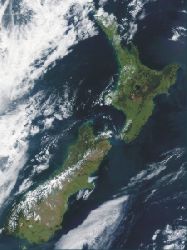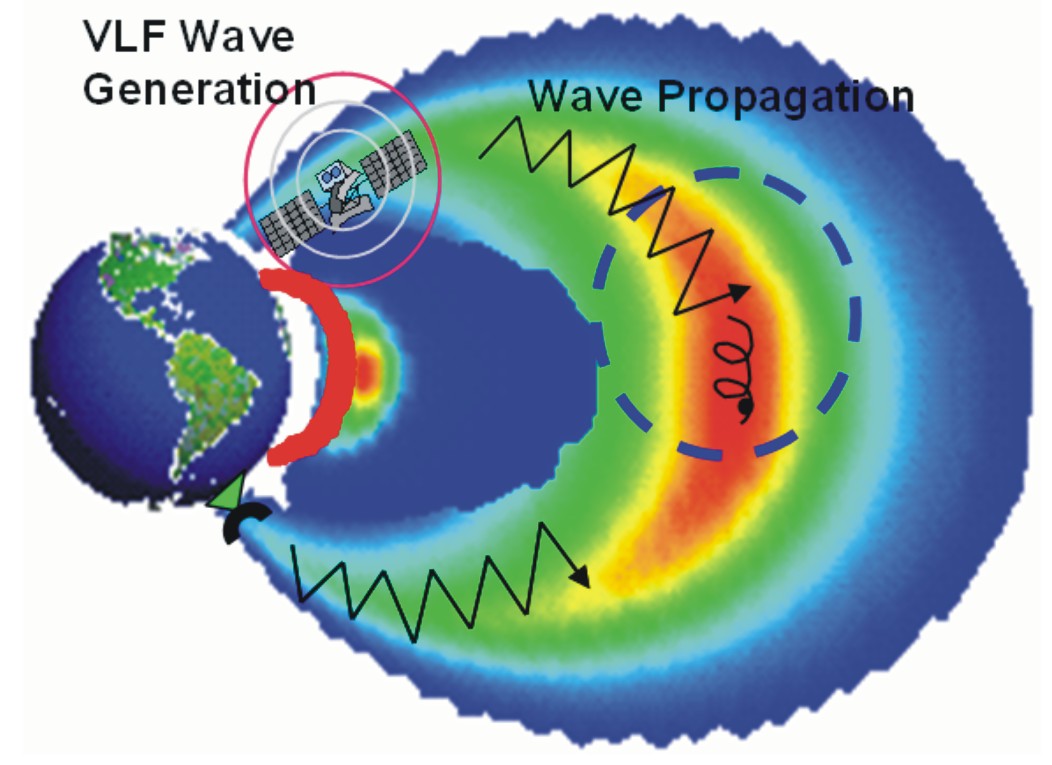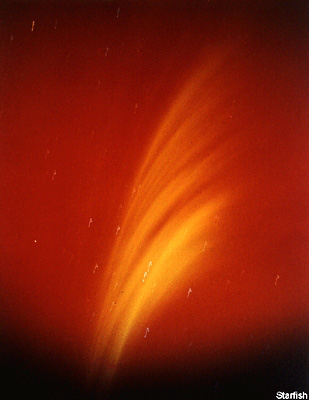
| Physics
Te Tari Hu-o-te-Kohau |
| Directory |
| About the Group |
| Publications |
| Recent and Current Projects |
| Group Images |
| Research Opportunities |
| Results from Darwin |
| Results from Colorado |
| Collaborators |

New Zealand from Terra Satellite
|
- International community needs to consider unintended effects of using system - A proposed If activated, the envisaged
“radiation belt remediation” system would significantly alter the upper
atmosphere in the short term, seriously disrupting high frequency (HF)
radio wave transmissions and GPS navigation around the globe, says the group’s
lead researcher, Dr
Craig Rodger of the University of
Otago Physics Department.
|
|
|
The remediation system aims to
protect hundreds
of low earth-orbiting satellites from having their onboard electronics
ruined by charged particles in unusually intense radiation belts “pumped up”
by high-altitude
nuclear explosions or powerful solar storms, says Dr Rodger.
The approach, which is being considered
by the US Air Force and the US Defense
Advanced Research Projects Agency, involves using very low frequency
radio waves to flush particles from belts and dump them into the upper
atmosphere over either one or several days.
|
 |
|
“We’ve calculated that Earth’s upper
atmosphere would be dramatically affected by such a system, causing unusually
intense HF blackouts around most of the world,” he
says.
“Airplane pilots and ships would lose
radio contact and some Pacific Island nations could be isolated for as long as
six to seven days, depending on the system’s design and how it was operated,”
he says.
GPS would likely also suffer large-scale
disruptions, as signals between ground users and satellites were scrambled
by the ionosphere, he added.
The disruptions result from a deluge
of dumped charged particles temporarily changing the ionosphere from a
“mirror” that bounces high frequency radio waves around the planet to a
“sponge” that soaks them up, he says.
In their paper, just published in
the August edition of the international journal Annales
Geophysicae, the Otago researchers and The researchers also calculated the likely effect of remediation on the ozone layer, but found that ozone depletion would be short-lived and similar to that resulting from natural processes such as large solar storms and volcanic eruptions. The paper, titled: “The atmospheric
implications of radiation belt remediation” was co-authored with Otago colleague
Associate Professor Neil Thomson and researchers from the British
Antarctic Survey, and the Sodankylä
Geophysical Observatory in The full
paper reference, including a link to the Annales Geophysicae website containing the
publication : The
atmospheric implications of radiation belt remediation.
Rodger, C. J. , Clilverd, M. A., Ulich, Th., Verronen, P. T., Turunen, E., and
Thomson, N. R.,
Annales Geophysicae, Page(s) 2025-2041. SRef-ID: 1432-0576/ag/2006-24-2025,Volume 24, Number
7, 2006. Alternatively, you could look at a copy of the article stored on our website,
which is available for non-commercial purposes related promoting space sciences, in accordance with the copyright rules for
Annales. |
![]()

![]()

|
Notes
and Background - Satellites
For more information on
the threats to satellites posed by high altitude nuclear explosions visit:
http://www.cndyorks.gn.apc.org/yspace/articles/nuclear_explosions.htm
The site features a copyrighted
article which originally appeared in Scientific
American magazine in June 2004
entitled "Nuclear Explosions in
Orbit", and has been reprinted with the permission of the author.
The article ends with several additional information sources.
It has been suggested that
a nuclear airburst at high-altitude would significantly
shorten the operational lifetime of Low Earth Orbiting satellites.
Even a "small" detonation (~10-20 kilotons) occurring at altitudes of 125-300
km, could lead to the loss of 90% of all low-earth-orbit satellites within
a month. In 2004 there were approximately 250
satellites operating in low-Earth orbit (LEO). These satellites fulfil
a large number of roles, including communications, navigation, meteorology,
military and science. In the event of a nuclear airburst at high-altitude,
or an unusually intense natural injection, this large
population of valuable satellites would be threatened. Due to the lifetime
of the injected electrons, the manned space programme would need to be
placed on hold for a year or more.
The radiation belts were discovered by James A. Van Allen
on Jan. 31, 1958, the first major scientific discovery of the early space age. He died last week (9th August) in Iowa City, at
the
age of 91. A Geiger counter on board the Explorer 1 satellite, developed by Dr. Van Allen, recorded two belts of
charged particles trapped by Earth.s magnetic field. One belt is 400 to 4,000 miles above the surface, and the other
is 9,000 to 15,000 miles high, both curving toward the magnetic poles. The Van Allen Belts remain a crucial area of
study in space science, as evidenced by a recently announced, $100 million NASA project to study the effect of
the belts on satellite communications and global navigation systems.
|
|
|
In the earliest days of
the Space Age, the US "Starfish
Prime" HANE, a 1.4 Megaton detonation
occurring at 400 km above Johnston Island in the central Pacific Ocean
on 9 July 1962, damaged 3 of the 5 satellites which operating in space
at the time. This included the world's first active communications satellite,
Telstar,
which failed due to radiation exposure, even though the satellite was
launched after the Starfish Prime explosion.
|
 Telstar 1 |
|
Notes and
Background – HF Communications
HF
radio frequencies are very important because of their wide uses. Many developed
countries use HF for radiocommunications
to and from aircraft and ships, international broadcasting, amateur operations,
and for fixed long-distance radiocommunications.
While little use is made of HFradiocommunications
in developed countries for domestic communications, lesser developed countries
still find HF cost-effective for their domestic radiocommunications
needs, such as for national broadcasting, mobile, and fixed point-to-point
communications.
Notes and
Background – GPS
The Global
Positioning System, usually called GPS, is the only fully-functional
satellite navigation system. A constellation of more than 24 GPS satellites
broadcasts precise timing signals by radio to GPS receivers, allowing them
to accurately determine their location (longitude, latitude, and altitude)
in any weather, day or night, anywhere on Earth. GPS has become a vital
global utility, indispensable for modern navigation on land, sea, and air
around the world, as well as an important tool for map-making and land
surveying. GPS also provides an extremely precise time reference, required
for telecommunications and some scientific research. The operation of an RBR
system would lead to serious GPS degradation at mid latitudes, a new and
unexpected experience for mid-latitude GPS users.
The University of Otago is New Zealand's oldest university. Located in Dunedin, Otago is the southern-most University of the country, with more than 17,800 students and 3300 staff. In New Zealand, universities are institutions where teaching is primarily undertaken by those engaged in research and scholarship. As New Zealand's oldest university, Otago has a long established tradition of research excellence. Since its foundation in 1869, the University has steadily increased its teaching and research activities, while building on its original strengths, including Physics. More information on the University of Otago can be found at: www.otago.ac.nz. British Antarctic Survey is a world leader in research into global issues in an Antarctic context. It is the UK's national operator and is a component of the Natural Environment Research Council. It has an annual budget of around £40 million, runs nine research programmes and operates five research stations, two Royal Research Ships and five aircraft in and around Antarctica. More information about the work of the Survey can be found at: www.antarctica.ac.uk The Sodankylä Geophysical Observatory is an independent research department of the University of Oulu, located in Lapland, and established in 1913 by Finnish Academy of Science and Letters to perform geophysical measurements and research based on the observation results. More information on Sodankylä Geophysical Observatory can be found at: www.sgo.fi. The Finnish Meteorological Institute is the agency responsible for gathering and reporting weather data and forecasts in Finland. The Institute is an impartial research and service organisation with expertise covering a wide range of atmospheric science activities other than gathering and reporting weather data and forecasts. The main research subject of the Finnish Meteorological Institute is the Earth's atmosphere. Other research topics include the study of near space and solar influence on the planet's atmospheres. More information on the Finnish Meteorological Institute can be found at: www.fmi.fi
Debris from Starfish nuclear test satellite on 9 July 1962 (400 km alt burst 1.4 MT), caused artificial aurora and damaged the Telstar 1 satellite, the worlds first active communications satellite
|
